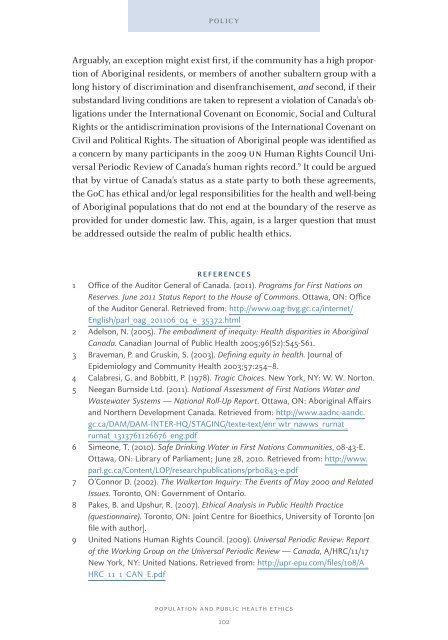PoPulationand Public HealtH etHics
PoPulationand Public HealtH etHics
PoPulationand Public HealtH etHics
Create successful ePaper yourself
Turn your PDF publications into a flip-book with our unique Google optimized e-Paper software.
policy<br />
Arguably, an exception might exist first, if the community has a high proportion<br />
of Aboriginal residents, or members of another subaltern group with a<br />
long history of discrimination and disenfranchisement, and second, if their<br />
substandard living conditions are taken to represent a violation of Canada’s obligations<br />
under the International Covenant on Economic, Social and Cultural<br />
Rights or the antidiscrimination provisions of the International Covenant on<br />
Civil and Political Rights. The situation of Aboriginal people was identified as<br />
a concern by many participants in the 2009 un Human Rights Council Universal<br />
Periodic Review of Canada’s human rights record. 9 It could be argued<br />
that by virtue of Canada’s status as a state party to both these agreements,<br />
the GoC has ethical and/or legal responsibilities for the health and well-being<br />
of Aboriginal populations that do not end at the boundary of the reserve as<br />
provided for under domestic law. This, again, is a larger question that must<br />
be addressed outside the realm of public health ethics.<br />
reFerences<br />
1 Office of the Auditor General of Canada. (2011). Programs for First Nations on<br />
Reserves. June 2011 Status Report to the House of Commons. Ottawa, ON: Office<br />
of the Auditor General. Retrieved from: http://www.oag-bvg.gc.ca/internet/<br />
English/parl_oag_201106_04_e_35372.html<br />
2 Adelson, N. (2005). The embodiment of inequity: Health disparities in Aboriginal<br />
Canada. Canadian Journal of <strong>Public</strong> Health 2005;96(S2):S45-S61.<br />
3 Braveman, P. and Gruskin, S. (2003). Defining equity in health. Journal of<br />
Epidemiology and Community Health 2003;57:254–8.<br />
4 Calabresi, G. and Bobbitt, P. (1978). Tragic Choices. New York, NY: W. W. Norton.<br />
5 Neegan Burnside Ltd. (2011). National Assessment of First Nations Water and<br />
Wastewater Systems — National Roll-Up Report. Ottawa, ON: Aboriginal Affairs<br />
and Northern Development Canada. Retrieved from: http://www.aadnc-aandc.<br />
gc.ca/DAM/DAM-INTER-HQ/STAGING/texte-text/enr_wtr_nawws_rurnat_<br />
rurnat_1313761126676_eng.pdf<br />
6 Simeone, T. (2010). Safe Drinking Water in First Nations Communities, 08-43-E.<br />
Ottawa, ON: Library of Parliament; June 28, 2010. Retrieved from: http://www.<br />
parl.gc.ca/Content/LOP/researchpublications/prb0843-e.pdf<br />
7 O’Connor D. (2002). The Walkerton Inquiry: The Events of May 2000 and Related<br />
Issues. Toronto, ON: Government of Ontario.<br />
8 Pakes, B. and Upshur, R. (2007). Ethical Analysis in <strong>Public</strong> Health Practice<br />
(questionnaire). Toronto, ON: Joint Centre for Bioethics, University of Toronto [on<br />
file with author].<br />
9 United Nations Human Rights Council. (2009). Universal Periodic Review: Report<br />
of the Working Group on the Universal Periodic Review — Canada, A/HRC/11/17<br />
New York, NY: United Nations. Retrieved from: http://upr-epu.com/files/108/A_<br />
HRC_11_1_CAN_E.pdf<br />
PoPulation anD <strong>Public</strong> <strong>HealtH</strong> <strong>etHics</strong><br />
102
















